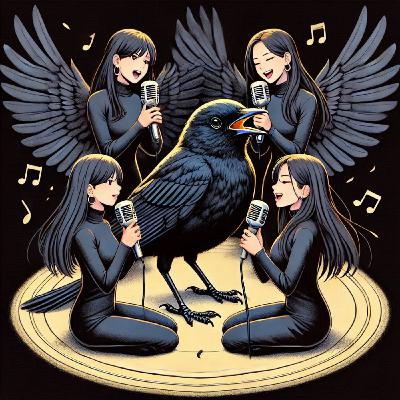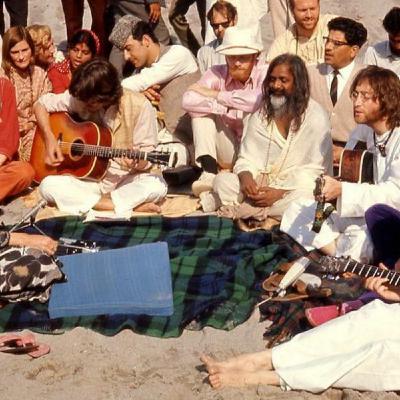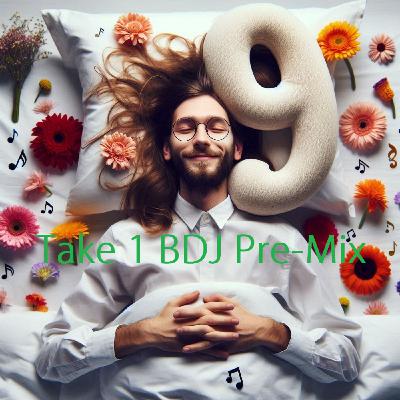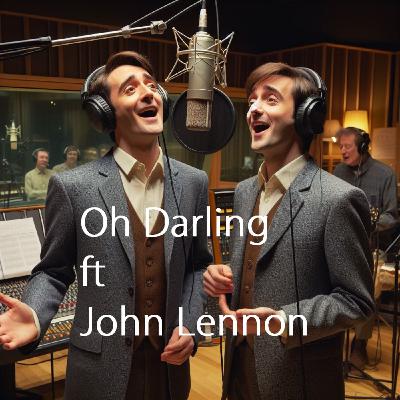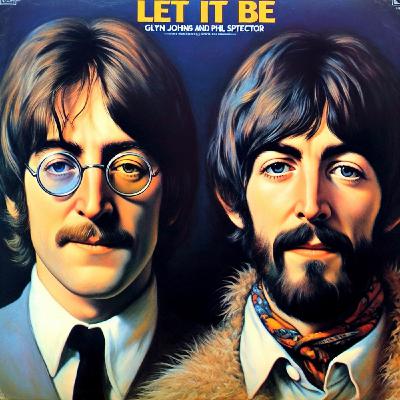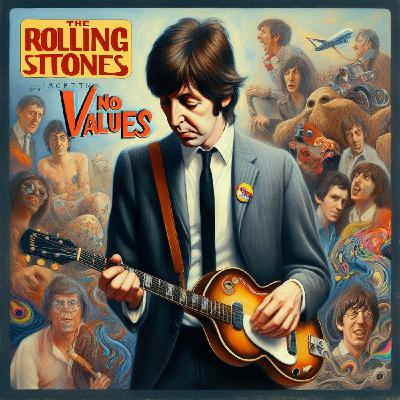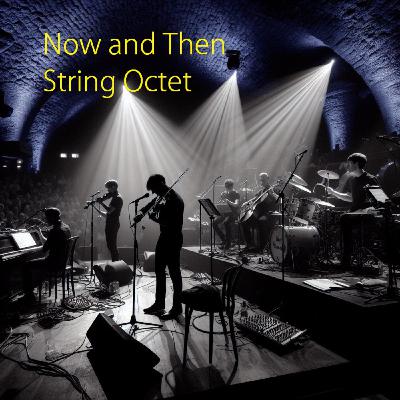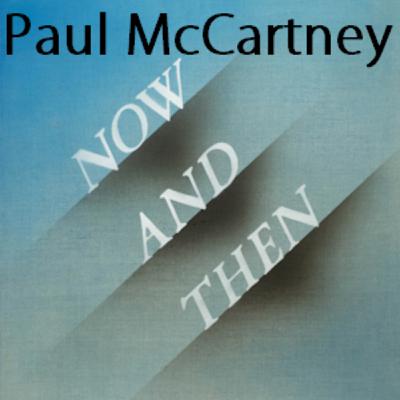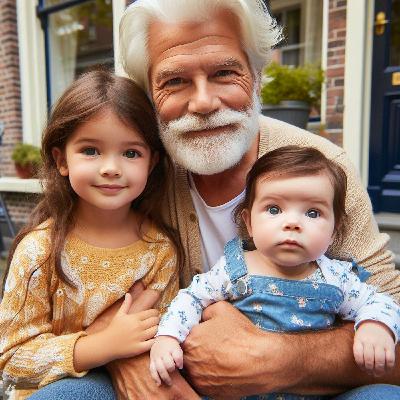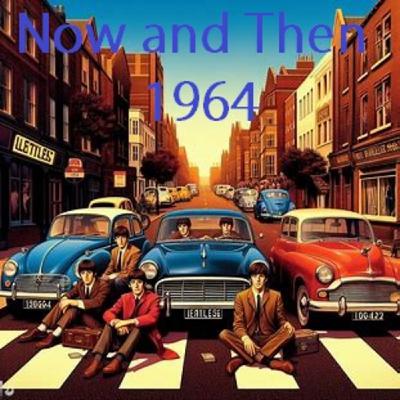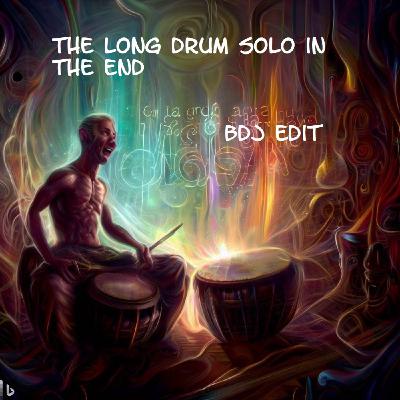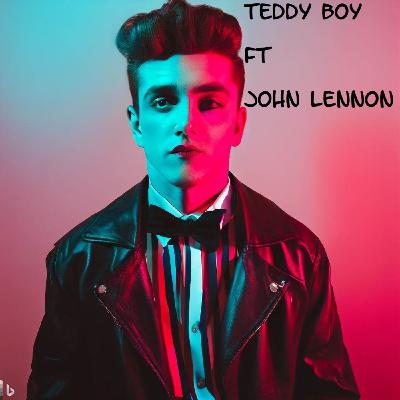Discover BDJ's Cellar Full of Remixes
BDJ's Cellar Full of Remixes

BDJ's Cellar Full of Remixes
Author: BDJ
Subscribed: 10Played: 3,049Subscribe
Share
© Copyright 2025 BDJ
Description
Once upon a time (or maybe twice) there were four magicians; and they made wonderful music, and called themselves The Beatles. In BDJ's Cellar, their spirits roam freely, they play and mix with other music, young and old.
282 Episodes
Reverse
Beyoncé's new cover of the Beatles' "Blackbird" on her "Cowboy Carter" album uses the original 1968 backing track by Paul McCartney, including his acoustic guitar and foot tapping. "Blackbird" was written by Paul McCartney for the Beatles' 1968 "White Album", inspired by the call of a blackbird during the Beatles' trip to Rishikesh, India. He later claimed it was a tribute to the civil rights movement. The song has a long history in Black music, with various artists like Aretha Franklin and Sylvester adding their unique interpretations. The Beyonce cover version, retitled "Blackbiird," features additional harmony vocals by four Black women in country music, Tanner Adell, Tiera Kennedy, Reyna Roberts and Brittney Spencer. Apparently, Beyonce looks to emphasize the song's historic meaning to her audience.Of course, McCartney should have invited Black singers to join him on the White Album original. An oversight, which we now can correct, thanks to the BDJ spectral remuxers. So, enjoy Macca's Blackbird with backing vocals by Tanner, Tiera, Reyna and Brittney.
The Beatles' journey to India in 1968 is a fascinating slice of rock 'n' roll history that continues to intrigue music fans and historians alike. It was a time of spiritual exploration and prolific songwriting for the Fab Four. The band, along with their wives, girlfriends, assistants, and a medley of other celebrities like Mike Love from the Beach Boys, traveled to Rishikesh to attend an advanced Transcendental Meditation training session at the ashram of Maharishi Mahesh Yogi.This retreat proved to be a creative boon forPaul McCartney, who wrote many songs during this period. It's widely acknowledged that a significant number of tracks from "The White Album" were penned in India, including "Birthday" and "Back in the USSR".The snippet of audio from India survives, where the Beatles and friends serenade Mike Love for his birthday. While it's difficult to pinpoint the exact source of inspiration for McCartney's compositions, it's certainly plausible that the camaraderie and musical exchange during such moments could have sparked ideas that later evolved into the tracks on "The White Album."
McCartney's 1987 single "Once Upon a Long Ago" carries with it a bittersweet tale of what could have been a historic collaboration. The song, which was part of McCartney's compilation album "All the Best!" and later released as a single, was initially composed with the Queen frontman in mind.The story goes that McCartney had envisioned the track as a duet with Mercury. However, due to Mercury's ill health and busy schedule, the collaboration never materialized. McCartney went on to perform the song solo, and it reached No. 10 in the UK Singles Chart. Artificial intelligence has opened up new possibilities, allowing fans to experience a version of "Once Upon a Long Ago" featuring Mercury's distinctive voice. This not only showcases McCartney's songwriting prowess but also pays homage to Mercury's enduring legacy.While it's true that nothing can replace the magic of a real-time collaboration between McCartney and Mercury, AI remixes offer a glimpse into an alternate universe where the two icons perform together."Once Upon a Long Ago" serves as a beautiful, if somewhat melancholic, tribute to the power of music and the enduring spirit of creativity that defines both McCartney and Mercury's contributions to the world of music.
It was 1968 when Peter Brown, a close associate of the Beatles, approached none other than Frank Sinatra to perform a unique rendition of "The Lady is a Tramp" for Maureen Starkey's birthday, Ringo Starr's first wife.Sinatra, with his unparalleled panache, transformed the classic into "Maureen is a Champ," a playful twist on the original lyrics, celebrating Maureen's vivacious spirit. The recording was intended as a private gift, a one-of-a-kind single that encapsulated the essence of an era where music was an intimate affair. Rumor has it that only one copy of this exclusive single survived, a testament to its rarity and the ephemeral nature of such personal tributes.The original features Sinatra's voice and piano accompaniment. We made a remix, crafted with the finesse of a complete orchestra, reverberating Sinatra's style, and echoing the grandeur of the original recording. The remix was a meticulous endeavor, requiring a deep understanding of Sinatra's musical nuances and the orchestral dynamics that could complement them. It shows how modern technology and reverence for musical heritage can coalesce to create something truly transcendent. The story of "Maureen is a Champ" is more than just a footnote in music history; it is a narrative that resonates with the notion that sometimes, the most personal gifts are the ones that echo the loudest through time.
The second single to be released from Walls And Bridges, ‘#9 Dream’ continued John's fascination with the number nine. He woke up one morning and wrote down the words along with the melody. He had no idea what it meant, but he thought it sounded beautiful.John produced the song himself. Until now, only demos (on guitar and piano) were known, but recently just over a minute of Take 1 became available. Our engineers produced a full song from this snippet. The production is more sparse and the vocals are less distorted than the official version on Walls and Bridges. Judge for yourself!
The Deluxe set of Lennon's 'Mind Games' album just arrived. It contains 6CD's and 2 Blu-ray discs. Asa result, there are (at least) 6 different mixes of each song on the album. How can a Remixer resist this temptation?The original Mind Games production sounds rather busy and massive, as if Lennon and co. wanted to include every instrument in the studio in the track, This tends to obscure the beauty of the composition. Furthermore, Lennon's vocals are double -tracked, and various effects added to them. So our task was to make a remix which is simple, and has only single-tracked vocals. We prefer our 'Relax-Mix' over the original, but we could be biased........
In an interview in the late 70's, Lennon said that he would have sung Oh Darling better than McCartney did. Unfortunately, Lennon did not supply a recording to substantiate his claim.But now, thanks to state-of-the-art-artificial-intelligence-technology, it is possible to create this unheard outtake of the Abbey Road sessions.Who do you prefer, John or Paul?
For You Blue is a song by the Beatles, written by George Harrison and released on their 1970 album Let It Be. Glyn Johns and Phil Spector were two of the producers who worked on the album, but they had different visions for the sound and style of the songs. Johns preferred a more raw and live approach, while Spector added orchestral overdubs and effects. Glyn Johns mixes were all rejected, and Spector's version was released as a single and on the album. But was the Glyn Johns production of For You Blue really worse than Spector's? To facilitate the comparison, we play the Glyn Johns version in the left channel, and Spector's mix in the right channel. It is evident that Johns liked Harrison's guitar, which is almost absent in Spector's mix. Much of the instrumental mixes are similar, but Spector includes a new version of the vocals. These were recorded after Johns left, so these new vocals were not available to him. But overall, were they right to reject Johns mix?
One of the rare original songs on McCartney's “Give My Regards To Broad Street” soundtrack was “No Values”. However, it was s not composed for the film. The song had been in the works since late 1980, when Wings did some demos that can be found on bootlegs. McCartney recorded another version of the song at AIR Studios on Montserrat in February 1981, during the Tug Of War sessions. The final version for the film was done in December 1982 at AIR in London, with the same musicians as on ‘Not Such A Bad Boy’.McCartney has said that "No Values" came to him in a dream, much like 'Yesterday' did. But here, he dreamt that the Rolling Stones were playing the song: "They were all there, Bill, Charlie, Keith and all the lads; and Mick was up there singing, “No values, seems to me that you’ve still got no values…” I couldn’t quite hear all the lyrics but I heard all the chorus and I woke up and thought I really like that song that they do. Then I thought, Hey, wait a minute – there is no song called “No Values”. They don’t do that song. My brain had just created it, or however it happens. I haven’t told Mick Jagger – he’d probably claim the copyright!"The 1980 outtakes still have a bit of a Rolling Stone feel, but by 1982 that had gone and it had become a typical 'Wings' track. A good occasion to set Artificial Intelligence to work, and produce a version of "No Values" with the Rolling Stones swagger; is this the way McCartney heard it in his dream?
The production of the last Beatles single, Now and Then, is lush, to say the least. A heavily compressed piano (McCartney) accompanies Lennon's vocals. The string octet kicks in, we hear backing vocals echoing all the way back to Abbey Road, and then somebody messes up a solo on a slide guitar. Of all these add-ons (that Lennon would have hated) the string octet stands out, because it is not that bad. It is choreographed very much in style of Eleanor Rigby, with short bursts of te violins and cellos. Well worth a listen in isolation.
We all know that Now and Then was composed by John Lennon. However, Paul McCartney took and changed it, omitted the middle eight, added a solo, played piano over Lennon's recording, and much more. And he sang almost the whole song in unison with Lennon's voice. You might say it became a McCartney song.......To take the transformation to completion, we deleted Lennon's voice from the mix, so we can fully appreciate McCartney's singing.
365 yesterdays have come and gone in 2023. It was an eventful year, with wars raging in many parts of the world. But it also brought great personal joy.As a farewell to 2023, here is Paul McCartney singing Yesterday. Just Paul, no guitar, no strings. Remember the good things in life.
The ending of the song I Am The Walrus is one of the most mysterious and intriguing parts of the Beatles’ catalogue. It features a mix of nonsense lyrics, random sound effects, and a snippet of a BBC radio broadcast of Shakespeare’s King Lear.Some people claim that the version of the song on the new Red and Blue album, a compilation of remastered Beatles hits released in 2023, differs from the original version that appeared on the Magical Mystery Tour EP and album in 1967. They say that the vocals are clearer and more isolated, and that some of the background noises are different or removed.To test this claim, we have isolated the vocals from the ending of the song. Here is what we found:
The vocals are indeed more audible and less distorted than the original version. This is probably due to the improved sound quality and remastering process of the new album.
The lyrics are still mostly nonsensical, but some of them can be deciphered more easily. For example, a French voice talks about the 'nouvelle republique' and the Vietnam war.
The radio broadcast of King Lear is also the same, but it is slightly more synchronized with the vocals. The broadcast was recorded by John Lennon from a transistor radio that he randomly tuned in while recording the song. The broadcast features the lines “O, untimely death!” and “I know thee well: a serviceable villain”, spoken by the characters of Edgar and Gloucester, respectively.
In conclusion, the version of I Am The Walrus on the new Red and Blue album does have some differences from the original version. The mystery remains whether the words that we can now hear are added new, or that they existed in the original but were mixed so low that we can't distinguish them.
Now and Then is a stunning remix of the long-lost Beatles song, featuring the original vocals of John Lennon and the contributions of his bandmates Paul McCartney, George Harrison, and Ringo Starr. This remix captures the spirit and sound of the Beatles in 1964, when they were at the peak of their popularity and creativity. George provides his melodic guitar riffs, Paul adds a catchy bassline and Ringo hits his drums with passion. This Re-Mix is rare treat for fans of the classic Beatles.
The song “I’m in Love” is attributed to Lennon–McCartney. John Lennon may have written it himself. He gave the song to the Fourmost, another band from Liverpool, who recorded it in 1963 with George Martin as the producer. Lennon claimed that he wrote the song for them in 1971, but he was not sure about it in 1980. Paul McCartney’s biographer, Barry Miles, suggested that the song was a joint work by Lennon and McCartney . Billy J. Kramer also made a recording of the song, but the Fourmost’s version was released and reached number 17 in the UK charts.The Beatles never recorded the song - until now. Using the latest techniques, it is possible to upgrade Lennon's demo (on piano) to a full song. Wouldn't it have fitted nicely on Beatles for Sale, With The Beatles?
'The End' is the last song in the medley of the Abbey Road album, and it is the only song in the Beatles' catalogue that features a drum solo by Ringo Starr. According to EMI engineer Geoff Emerick, who worked on the album, the solo was originally longer, but it was edited down to fit the song's length. Our BDJ engineers have made a remix of the Beatles song 'The End', which features an extended drum solo by Ringo Starr. This solo is based on the original recording that was cut short for the Abbey Road album, as well as the inspiration that Ringo drew from the drum solo in 'In-A-Gadda-Da-Vida' by Iron Butterfly.'In-A-Gadda-Da-Vida' is a song by Iron Butterfly that is considered one of the first examples of heavy metal music. It was written by the band's vocalist and organist Doug Ingle, who allegedly slurred the words 'In the Garden of Eden' when he was drunk. The song features a long instrumental section that includes a drum solo by Ron Bushy. We have combined elements of both drum solos and created a remix of 'The End' that showcases Ringo's talent and style. If, at some time,, the original recording of Ringo's solo emerges, then we will know how accurate this version of the solo is.
Here is a new release of Honey Don't, the classic rockabilly song by Carl Perkins that was covered by The Beatles in 1964. In this remix, we have restored the original vocals by John Lennon, who used to sing the song during live performances before Ringo Starr took over the lead vocals on the studio version. Honey Don't is a song that showcases Lennon's raw and energetic vocal style, as well as his playful interaction with the audience. It is a tribute to one of his musical heroes, Carl Perkins, who also wrote other songs that The Beatles recorded, such as Matchbox and Everybody's Trying to Be My Baby. We hope you rediscover the charm and charisma of John Lennon as a rockabilly singer.
"Let Me Roll It" is a song by Paul McCartney and Wings, released on their 1973 album Band on the Run. The song was also released as the B-side to "Jet" in early 1974, and has remained a staple of McCartney's live concerts since it was first released.The song is unique in the Beatles catalogue, since it combines contributions from McCartney, Lennon, Harrison and Bob Dylan!Of course, McCartney is credited as the composer, but he took the title (and the phrase in the lyrics) from "I'd Have You Anytime". And that song was written by George Harrison and Bob Dylan.The connection with Lennon is clear, but details are still debated; some say that Let Me Roll It was McCartney's version of Lennon's :Cold Turkey". Indeed, the dominating guitar riff is very reminiscent of Cold Turkey.Others maintain that Lennon used "Let Me Roll It" for his 1974 song "Beef Jerky."We will probably never know for sure, but what we DO know is what it sounds like if Lennon had covered Let Me Roll It.........
Here is stunning version of the song Good Night with vocals by Frank Sinatra. Good Night is a lullaby that John Lennon wrote for his son Julian, and was the final song on the Beatles’ 1968 album The Beatles. The Beatles recorded the song with an orchestra arranged and conducted by George Martin, and Ringo Starr sang the lead vocals. Lennon was probably embarrassed to sing it himself, as he considered it too sentimental1. Sinatra would have made it a classic hit, with his smooth voice and impeccable phrasing.
Imagine hearing John Lennon sing one of Paul McCartney’s songs that he famously dismissed as “granny music”. Well, you don’t have to imagine anymore, because the BDJ producers have used artificial intelligence to create a stunning version of the song Teddy Boy with vocals by John Lennon. Teddy Boy is a folk rock song that McCartney wrote during the Beatles’ 1968 visit to India, and recorded for his solo album McCartney in 1970. The Beatles also attempted to record the song during the Get Back sessions in 1969, but Lennon showed little interest and often parodied the lyrics. The song was left out of the final release of Let It Be. Now, thanks to the power of AI, you can hear how Lennon would have sung the song!
Comments
 United States
United States

